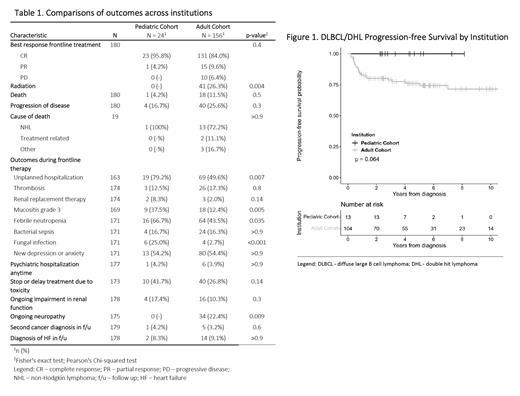Introduction: Standard treatment regimens for pediatric and adult patients with mature B-cell lymphomas vary significantly. For adolescent or young adult (AYA) patients, who may be candidates for either pediatric or adult regimens, limited data are available regarding comparative toxicities and efficacy for adult versus pediatric therapies.
Methods: A retrospective review was completed for individuals aged 12-39 years at diagnosis with aggressive mature B-cell lymphomas seen between 2011 to 2023 at Ohio State University Comprehensive Care Center (adult cohort) and Nationwide Children's Hospital (pediatric cohort). Diagnoses included diffuse large B cell lymphoma (DLBCL), double hit lymphoma (DHL), Burkitt lymphoma (BL), primary mediastinal B cell lymphoma (PMBCL), grey zone lymphoma (GZL), and unclassifiable high-grade B cell lymphoma (HGBCL). Progression free survival (PFS) and overall survival (OS) were calculated using the Kaplan-Meier method and compared by log-rank test. Differences between adult and pediatric cohort were compared using Fisher's exact test and Chi-squared test. Cox regression model was used to identify prognostic factors for PFS.
Results: Among 180 eligible AYA patients, 156 were treated at the adult center and 24 at the pediatric center. The median age was 30 years (median 15 pediatric [range 12-18] and 31 adult [range 21-39; p<0.001]). Other characteristics included male sex in 75% of pediatric vs 65% adult patients (p=0.3), stage 4 disease in 25% vs 47%(p<0.001), CNS involvement in 8.3% vs 5.4% (p=0.6), and LDH >2x upper limit of normal in 21% vs 31% (p=0.2). The overall median follow-up was 4.8 years (4.5 vs 4.8, p=0.7). Adult center histology included DLBCL (95); DHL (9); BL (8); PMBCL (31); GZL (4); and HGBCL (9). Pediatric diagnoses were DLBCL (13); BL (8); PMBCL (2); and HGBCL (1).
The most common treatments included R-CHOP (57), R-EPOCH (56), RM-CHOP (20), and R-CODOX-M/R-IVAC (16) at the adult center and CCG5961 (7), ANHL1131 (15), and ANHL0221 (1) protocols at the pediatric center. CCG5961 Group B protocol includes pre-phase, induction, and consolidation phases of COP, COPADM, and CYM. Group C includes the same pre-phase and induction, except for higher doses of MTX, with CYVE consolidation with high-dose MTX and randomization to 1 or 4 cycles of maintenance. ANHL1131 protocol was like CCG5961; major differences include randomization to receive rituximab during induction and consolidation and 2 cycles of maintenance for group C patients. ANHL0221, a PTLD protocol, involves 2 cycles of cyclophosphamide, prednisone, and rituximab followed by 4 cycles of cyclophosphamide and prednisone.
A greater incidence of unplanned hospitalization (79% pediatric vs 50% adult, p=0.007), grade 3 mucositis (38% vs 12%, p=0.005), febrile neutropenia (67% vs 44%, p=0.035), and fungal infections (25% vs 3%, p<0.001) were observed for the pediatric cohort (Table 1). Patients in the adult cohort were more likely to receive radiation therapy (26% vs 0%, p=0.004) and experience neuropathy at last follow-up (22% v 0%, p=0.009). Among all patients, other adverse events during follow-up included diagnosis of depression/anxiety (93), heart failure (16), impaired renal function (20), and secondary malignancy (6) (Table 1).
For the total population, 2-year PFS was 78% (88% pediatric vs 77% adult, p=0.35), and 2-year OS was 93% (96% vs 92%, p=0.31).
For patients with DLBCL or DHL, there was a trend towards improved PFS in the pediatric versus adult cohort (p=0.06, Figure 1), and on univariable analysis a trend towards lower risk for progression with receipt of a more intensive regimen compared with R-CHOP/R-MCHOP (hazard ratio 0.46, 95% confidence interval 0.2-1.1, p=0.07).
Conclusions: We observed a higher incidence of short-term adverse effects including severe mucositis, febrile neutropenia, and fungal infection, but lower rates of radiation consolidation and ongoing neuropathy in AYA patients with aggressive mature B-cell lymphoma treated with pediatric versus adult regimens. Relatively higher dose intensity (compared to adult treatments), standard use of CNS prophylaxis, and lower dosage of vinca-alkaloids likely account for the greater incidence of short-term adverse effects and lower rates of neuropathy seen in patients treated at pediatric centers. Further study is needed to evaluate differences in efficacy between treatment approaches in AYA patients with DLBCL/DHL.
Disclosures
Epperla:Incyte: Speakers Bureau; Novartis: Consultancy, Honoraria, Membership on an entity's Board of Directors or advisory committees, Speakers Bureau; Merck: Consultancy, Honoraria, Membership on an entity's Board of Directors or advisory committees; ADC Therapeutics: Consultancy, Honoraria, Membership on an entity's Board of Directors or advisory committees; Lilly: Consultancy, Honoraria, Membership on an entity's Board of Directors or advisory committees; Beigene: Research Funding, Speakers Bureau. Christian:Genentech: Research Funding; Acerta: Research Funding; Millenium: Research Funding; BMS: Research Funding; F Hoffman-La Roche: Research Funding. Baiocchi:Prelude Therapeutics: Consultancy; EUSA: Consultancy; Viracta: Membership on an entity's Board of Directors or advisory committees; Atara Biotherapeutics: Membership on an entity's Board of Directors or advisory committees. Voorhees:Recordati: Consultancy, Research Funding; Morphosys: Research Funding; Incyte: Research Funding; AstraZeneca: Research Funding; Novartis: Consultancy. Maddocks:Janssen: Consultancy, Honoraria; Eli Lilly and Company: Consultancy; Seattle Genetics: Consultancy; Novartis: Research Funding; BMS: Consultancy, Research Funding; AstraZeneca: Consultancy, Research Funding; BeiGene: Consultancy; Epizyme: Consultancy; Gilead/Kite: Consultancy; Morphosys: Consultancy; Pharmacyclics: Consultancy, Research Funding; GenMab: Consultancy; Merck: Research Funding; Incyte: Consultancy, Honoraria; Genentech: Consultancy; ADC Therapeutics: Consultancy; Celgene: Consultancy, Research Funding; AbbVie: Consultancy. Sawalha:Celgene/BMS: Research Funding; Beigene: Research Funding; TG Therapeutics: Research Funding. Brammer:Verastem: Research Funding; Seattle Genetics: Membership on an entity's Board of Directors or advisory committees, Speakers Bureau; Kymera: Consultancy; Incyte: Research Funding; Dren Bio: Consultancy; Bristol Myers Squibb: Research Funding. Bond:Novartis: Consultancy, Research Funding; SeaGen: Consultancy; Incyte: Research Funding; Nurix Therapeutics: Consultancy, Research Funding.


This feature is available to Subscribers Only
Sign In or Create an Account Close Modal